

To navigate the Prospect Hill pages, use the menu dropdown at the top of each page
This is the story of a three block area in downtown Omaha, and the changes to it over the past 120 years. It's the story of the Fairfield house, the Woolworth mansion, and because the Fairfield house was designed by famed Omaha architect Thomas Rogers Kimball (click his name for his bio), the Kimball mansion and the Mary Rogers Kimball mansion. All of these houses were in the three block area, and only one survives today. It also chronicles some of their owners' lives.

Here is the three block area today. The blue square is where Thomas Kimball's mansion was; it was torn down to build a grocery store(!), but today an AC/Heating company is in the buildings.
Circled in red, the Mary Rogers Kimball house is located at 2236 St. Mary's Avenue in Omaha; it was designed by Kimball for his mother and sister, and built around 1905. His mother died at age 97 in 1930, and is buried at Forest Lawn, as is her son. It's just about the only one of the old mansions in that particular area that is extant.
The green square is where the Fairfield house and Woolworth mansion would have been; the address of the Woolworth mansion was 2211 St. Mary's Avenue. The Rorick Apartments are there today, which makes sense because they were built around the early 1950's, when the Woolworth and Fairfield residences were torn down.
Fairfield and Woolworth Family
Meliora Clarkson Woolworth Fairfield was the daughter of James Woolworth, whose marker and family is discussed on the Woolworth page on this site; Meliora's story is on the Fairfield page. She married Edmund Fairfield in 1900, and her father built a large house for them in Omaha in 1904, designed by Thomas Kimball. They had two daughters, Elizabeth and Mary Wynne. Edmund died in May 1929, just six months before the 1929 stock market crash, and Meliora in 1956. I know nothing about where their family ended up, beyond where Edmund and Meliora (probably either a cenotaph or a portion of her ashes) are buried.
In Omaha they lived in the Thomas Kimball-designed house for about 17 years. While searching for a photo of Meliora, I had found an "Architectural Review" article from 1904 that detailed the building of the house, with pictures of it but no idea where it was in Omaha. The Fairfield house captivated me; it looked nothing like most of the other turn of the century houses I'd seen in Omaha. I wanted to find that house and take pictures of it, if it were still in existence, a tough chore given that so much had been destroyed in the past 70 years.
The City Directory for 1910 gave Edmund's address as 2219 St. Mary's Avenue, which wasn't much help because it might also have been his work address. That part of town was filled with upscale houses around the turn of the century, but by the 1940's it had begun to work its way downhill, and nearly all of the beautiful mansions were torn down. When I was growing up in the 1960's, it still had old turn-of-the-century houses that had seen better days, but even I don't remember seeing mansions like those on this page then. They had all been gone long before I was born.
When I started the page about Meliora I had no idea where the research for it would take me, from the Nebraska history website the federal government maintains, the Douglas County Historical Society, Google archives, Thomas Rogers Kimball resources, and strangely enough, eBay; that research spawned this page, which is about the houses in her life and neighborhood. I also had no idea how long it would take to find out what I have; I'd been working on this for at least eight months, when I had the time.
I search eBay regularly for Omaha-related photos, and in the past year a seller has been auctioning quality reproductions of famous old photos by John Vachon, who travelled all over the country in the Depression taking photos of everything. One of those photos was of a large mansion that took up an entire city block, with a "for sale" sign in the yard. I'd seen the photo at least six months ago and thought about buying it because I love old Omaha homes, but didn't. Just this week, December 2012, a new round of auctions was posted and that photo was for sale again. eBay is a fountain of information for a lot of reasons, and it sometimes functions as a living museum. People sell anything on it, and historical documents and photos show up routinely.
This time I bought the photo, because I'd found something astonishing in it; it included a small corner of the house that sat next to the mansion. After I'd put up the photos of Meliora's house, which are at the very bottom of this page, I was extremely familiar with the front tudor woodwork of the house, and at the corner of the photo on eBay I saw this same woodwork. At first, I couldn't believe it was the Fairfield house; it was just so surprising to see it on eBay. The seller had no idea of the address of the mansion, so I wasn't any closer to confirming exactly where the Fairfield house was.
After more searches on the government's Nebraska history site, I was looking through the photos of the houses from around the turn of the century. And there, just as if it had been patiently waiting for me to find it, was a photo of the James Woolworth mansion at 2211 St. Mary's Avenue. I also found an entry on another website that gives the Woolworth mansion's name as "Cortlandt." Another article mentions that James' house back east had been named Cortlandt as well, and they named this new house after their old.
It's the same house in the photo I had just purchased on eBay, only 50-some years younger. The first photo below is the older photo from about 1895 on the OPL site; the second is the Vachon photo from about 1938. Meliora grew up in the Woolworth mansion (and her first daughter was born there, before the new house was built), and her father must have built the house for her and Edmund to keep them close. James Woolworth was two years away from dying from diabetes complications when the Fairfield house was built, and it's possible Meliora helped care for him, due to the proximity of the houses.
Woolworth left both houses to Meliora. The Fairfield house and the Woolworth mansion were both torn down in 1950. The mantel in the Woolworth mansion was given to the Nebraska Historical Society before demolition, according to a 1950 World Herald article. The Woolworth mansion was the first house in Omaha to have electricity.
Knowing this area today, I can hardly picture the bucolic look of it in the 1890's. Sadly, it's truly been changed beyond anything the Woolworth, Kimball and Fairfield families would recognize.
It's a shame the Fairfield house, the Woolworth mansion, and the Thomas Kimball houses are all gone, simply because they were something unique. These magnificent houses should have been preserved in some way; instead we have apartments and mediocre storefronts.
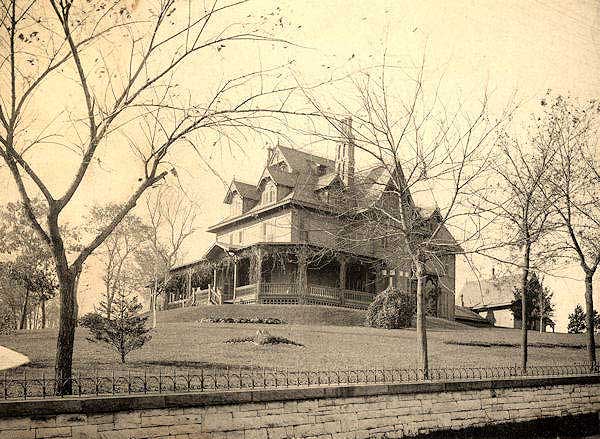
Woolworth Mansion, circa 1895
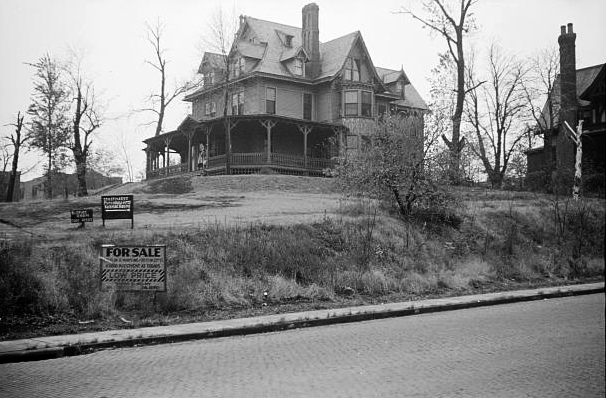
The Woolworth Mansion, circa 1938, taken by John Vachon, with the corner of the Fairfield house showing to the right. Notice the way the yard has deteriorated, and the retaining wall is completely gone.
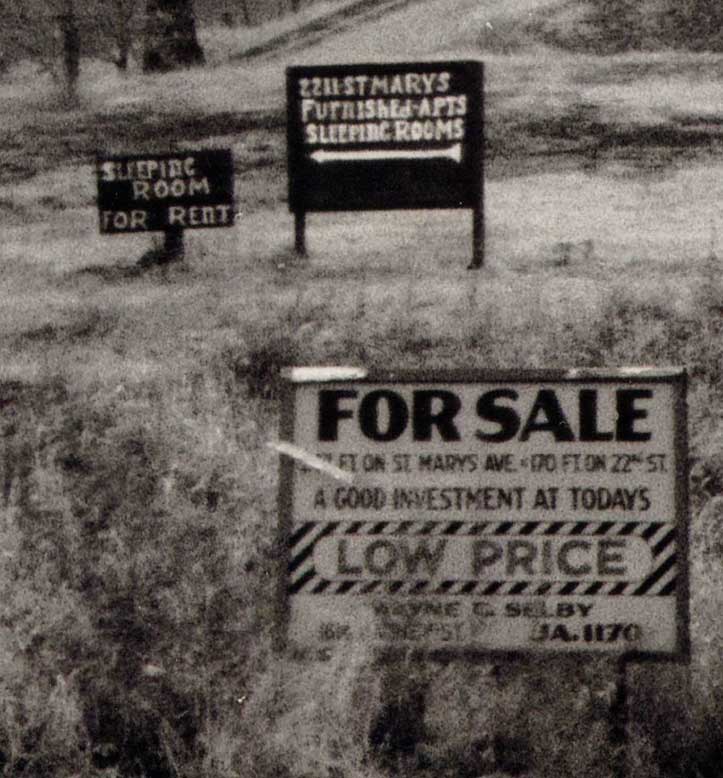
A close-up of the signs in front of the house. The old mansion had been changed into a rooming house as a final indignity, as a lot of the old houses in that area were during the Depression and some still are today. I find the bottom photo particularly depressing; it's hawking the land for investment, which nearly always means the razing of the property for a business. This is just what eventually happened.

Another view of the Woolworth mansion, from the front.
Kimball
Thomas Rogers Kimball was the pre-eminent architect here in Omaha from the 1890's to the years before the Depression. He designed many buildings and mansions in Omaha and the midwest, which include:
- The Trans-Mississippi Exposition in 1898, for which he functioned as principal architect and layout planner;
- St. Cecilia's Cathedral (which took 50 years to complete, as they had to keep raising money to pay for it!);
- The Hotel Fontenelle, THE place to stay in early Omaha through the 1960's, demolished in 1983. JFK and Jackie stayed there during his 1960 Presidential campaign stop;
- The magnificent old Omaha Public Library (where I spent the majority of my childhood and adolescence every Saturday, and every summer), which was renovated into office space when the new library was built in the 1980's;
- Monmouth Park Grade School on 33rd and Ames in Omaha, which was demolished in 1995; it was a gracefully designed building that I always adored. A postcard pic of it is here, probably taken around 1905, based on the newly planted trees. By the time I used to pass by it, the trees had grown tall around it and it looked much prettier.
- The Thomas Megeath mausoleum at Prospect Hill Cemetery in Omaha; and
- The Gurdon Wattles house in Omaha (Wattles was the main person behind the Trans-Mississippi Exposition held here in Omaha in 1898 - See this link for my story and pictures on the house Wattles had in Los Angeles, which is also an architectural marvel and part of a fight to preserve, and this link for some history on the house).
Kimball's huge mansion was built around 1905 a block away from the Fairfield house, at 2450 St. Mary's Avenue, and it too was razed to make way for a grocery store; how uncaring Omaha was, and is, for its architectural treasures. Click here for a different view of Thomas Kimball's own house. A direct shot of Kimball's house from St. Mary's Avenue is directly below, from the same Nebraska Memories website; photo courtesy of the Omaha Public Library, which has a wonderful collection of old Omaha memorabilia.
Kimball seems to have either had a lot of enemies, or he was a hard man to get along with, or both. Rumors were started that the Capitol tower he created was poorly designed, and he also jumped into the fray when his partner in Walker and Kimball was harassed by the men planning the Missouri Exposition.
In a much longer, and far more funny, fracas, Kimball had a row with his neighbors over the large assortment of chickens, roosters, ducks and dogs that he kept on the land by his mother's house, and the noise they made, in 1929. The tenants of nearby apartment buildings would be startled out of sleep at 4:30am every morning by the roosters crowing, dogs barking and ducks quacking. There was a maternity hospital near it that was constantly disturbed, and a church that aledged that the services were interrupted by the noise of the birds on Sunday mornings. It got so bad the groups banded together and took Kimball to court. They brought in over 30 witnesses to tell their story of being disturbed by the sounds, and the smells, of all these animals. Kimball's attorney countered that the Kimball property was in a zone that allows "industrial enterprises," and does not prohibit the owning of livestock that is kept enclosed, as the animals were.
Kimball took the stand on day three of the trial, and said that he raised the Rhode Island Reds for fighting, which he freely acknowledged, so this must have been a popular sport in early Omaha if he'd been doing this for 45 years, as he testified. He said that the people having parties in the apartment buildings threw bottles into his yard on purpose, which disturbed the "patrol ducks," which he said he keeps to guard the area. They in turn woke up the roosters which woke up the neighbors. He had culled his number of chickens and roosters from 500 (!!!!) down to 185, after protests in 1923.
The verdict on this was rather confusing. The judge ruled the animals were a nuisance, but didn't say exactly what should be done with them so there was no order to remove them. Kimball took the matter to the Nebraska supreme court but lost there as well. He was forced to move the birds somewhere else, though I don't know where he moved them to. This seems to have been the result of the city growing, with older residents from a more rural time who were used to keeping animals, colliding with the newly citified inhabitants who wanted a real city atmosphere. I think I would have complained about 500 birds myself.
Thomas Kimball died destitute in 1934, after the Depression wiped his assets away, and his wife died in 1937, still living in the house on St. Mary's Avenue. The Depression did much damage to the old way of doing things, and with WWII coming along as the country came out of it, great changes came in its wake. The grand old architecture of the previous years was not appreciated in the same way.
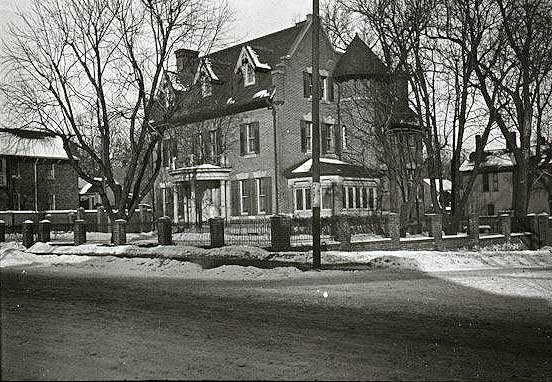
The Thomas Kimball Mansion

The Fairfield House
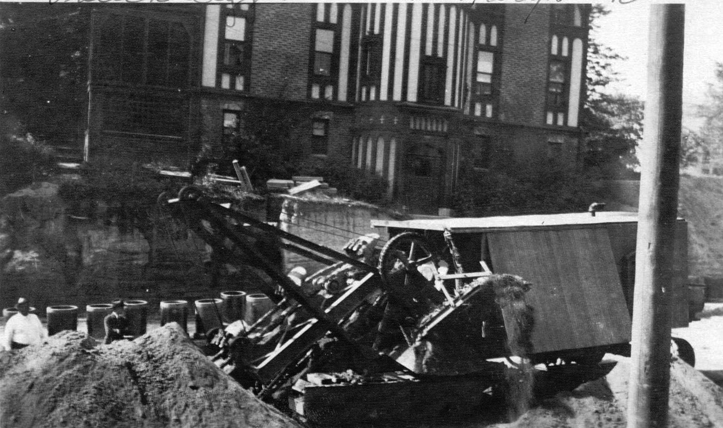
My thanks to Jeffrey Spencer, who sent me this photo of St. Mary's Avenue being lowered in about 1920, with the Fairfield house in the background. The land downtown Omaha is built on was once much higher. Over the years the big hills that used to run along the Missouri River have been lowered, and all of them are now virtually gone; there are many photos out there of 1880's houses sitting on tall earthen cliffs, while the street next them is 20-30 feet lower. The long walk up Dodge Street from 16th to 21st is still a fairly steep incline, but nothing like it originally was.